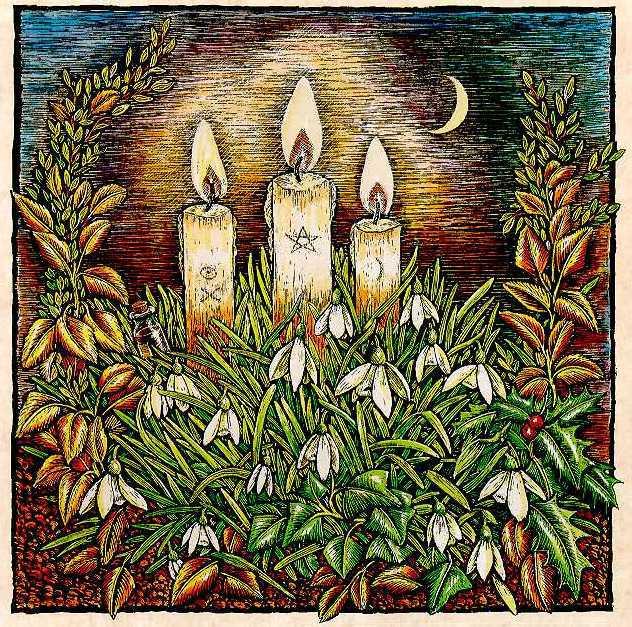 Most of us know February 2 as Groundhog Day and think of it as little more than a silly superstition. But did you know that Groundhog Day is a vestige of an ancient holiday which marks the midway point between the winter solstice and spring equinox?
Most of us know February 2 as Groundhog Day and think of it as little more than a silly superstition. But did you know that Groundhog Day is a vestige of an ancient holiday which marks the midway point between the winter solstice and spring equinox?
For those of us living in the wintry northern hemisphere, making it half-way through winter is a cause for celebration!
This time of year has been celebrated for centuries in many ways in many places. Candlemas refers to the Christian festival, marking 40 days after the birth of Christ. It is a holiday of purification, with the candles representing the purifying nature of light, both spiritually and physically. It is also the ritual end to the Christmas season, and often Christmas greenery are burned on this day, and holiday decorations are put away.
But even before the creation of the Christian liturgical year, in agrarian societies, people were greatly attuned to the turning of the seasons, and celebrated the summer and winter solstices: the longest and shortest days of the year; the equinoxes, the days halfway between the solstices which mark the beginning of the spring and fall seasons. They also celebrated the cross-quarter days between the equinox and the solstice. Candlemas is such a day.
Candlemas is a time of year when the lengthening of daylight hours becomes noticeable. The day is celebrated because it means that winter will soon be over, and spring will come. The time of darkness and fallow earth will soon end, and new light and life-sustaining growth will come.
During a time when one’s diet and income relied on what could be grown locally, the end of winter was more than a time of cabin fever and seasonal depression–it could also be a time of hunger and poverty.
Pagan Roots
When the early church created its liturgical calendars and feast days, they mapped them onto existing Roman pagan holidays, which corresponded with the solar calendar. February 2nd was celebrated as the feast day of Juno Februata, the virgin mother of the god Mars. In the Christian liturgical year, this feast day became Candlemas, and celebrated the Purification of the virgin mother of the Christian God, Jesus, and the presentation of Christ in the temple.
Meanwhile, in Celtic lands, the winter cross-quarter day was celebrated as Imbolc, a feast honoring Brigid who, in Celtic tradition, is a goddess of the Dawn, of healing, of fertility. The feast day in her honor marks the beginning of the lambing season, a sign of the earth coming back to life after the fallow time of winter. As Celtic Christianity developed, Imbolc became Candlemas, and Brigid became a saint, and the celebrations merged. It is known as a celebration of hearth and home, of the coming warmth, of fertility and purification and new life.
People lit candles or bonfires as a sign of the warmth of the sun to come. They made “Brigid’s crosses” from rushes, and dolls of Brigid were carried from house to house to bring her blessings. People also made pilgrimages to holy wells and brought back water to bless the home.
How the Groundhog Stole Candlemas
As a time dedicated to anticipating the spring, weather divination customs developed, the precursor to our celebration of Groundhog Day in the United States.
A popular Scottish verse goes:
In other words, if it’s a dry, sunny day on Candlemas, there’s a lot more winter to come. If it’s cloudy and cold, spring will be here soon. Sound familiar?
This conventional wisdom about the weather at Candlemas being predictive of the end of winter turned into lore that if hibernating bears wake from their hibernation and go back to sleep, that winter would stick around, but if they stayed out, spring was near.
This evolved into the familiar Groundhog Day, The legend has it that if the groundhog comes out on February 2 and the weather is sunny, he will be scared by his own shadow and go back into hibernation for six more weeks of winter. But if it’s cloudy, he will not be frightened and spring will come quickly.
When we put these traditions together, we see a pattern of the celebration of the changing of light, fire and fertility, celebrating the end of the dark days and the promise of the coming light.
Celebrating Candlemas at Home
If you want to extend your celebrations beyond the observation of Groundhog Day and bring more meaning to the holiday, here are some other ways to celebrate Candlemas:
- Make and light candles. The simplest tradition is to bring light into your home by lighting candles. Beeswax candles are traditional.
- Recite the following verse when lighting your candles:
From Seven Times the Sun by Shea Darian
- Read about St. Brigid then make a Cross of St. Brigid using rushes, straw, willow branches, as available, or pipe cleaners or plastic straws.
- Clean house. Anticipate the coming of spring by engaging in some spring cleaning. Put away the winter decorations, and bring in signs of spring. If your climate is warm enough, put away winter clothes, and bring out the spring clothes. Make a bonfire and burn your Christmas tree, or any other remnants of winter.
- Plant seeds, or make art with seeds, a symbol of fertility.
- Decorate a nature table with with symbols of spring.
- Read poems and sing songs with children about spring. Many can be found in the volume Spring from the Wynstones seasonal book series.
Happy Candlemas!
Were you familiar with Candlemas prior to reading this article? Are you inspired to celebrate? Please share your comments and any suggestions of other ways to observe the holiday.

3 comments
Thank you so much for sharing this information. I feel inspired and strengthened by the loving, kind and
helpful celebrations and natural inner sharing of the seasons and the light that we humans have
observed and celebrated from ancient roots. I think there are some similarities to our church
observations.
Thank you so much for the article. I have found a lovely Candlemas song, that really brings the celebration home to me. Here is the link to the pdf of the song: https://drive.google.com/file/d/0B-cAq5F7sueHTTd2NFhoblpYRUE/view —AND here is the link a sweet version of the song on youtube: https://www.youtube.com/watch?v=yqs7lcZvSA8